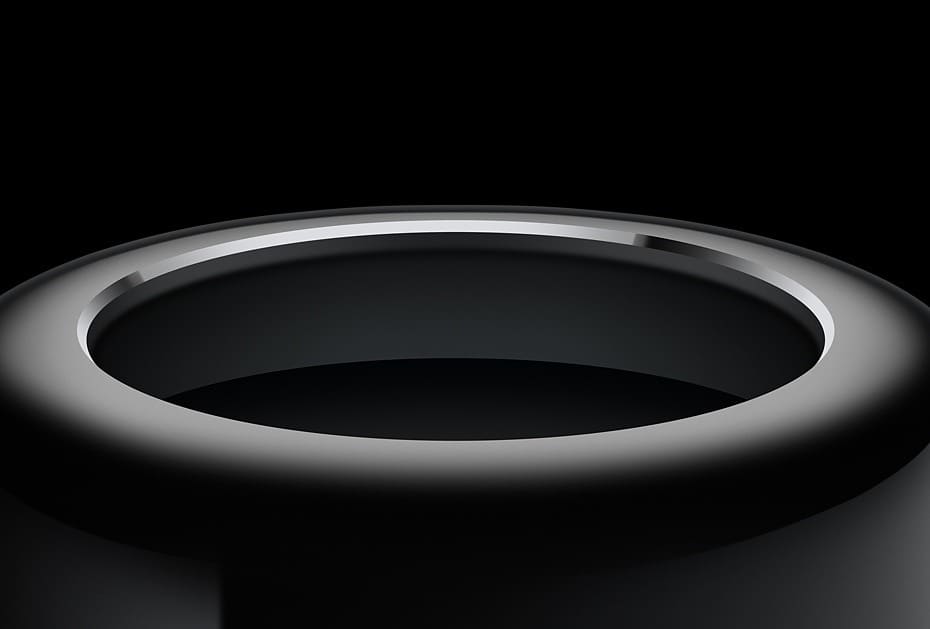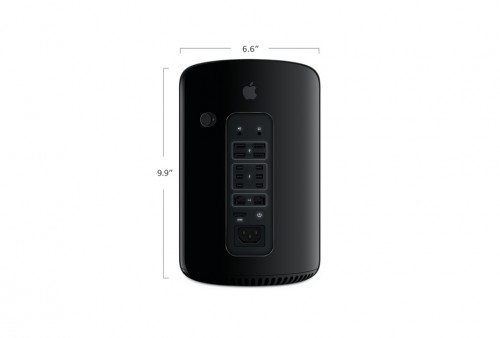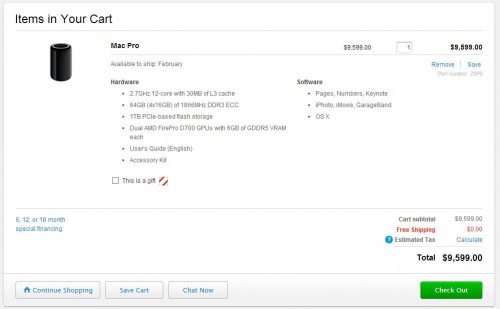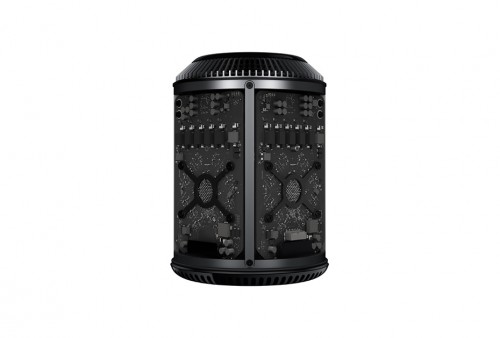Today, Apple launched their new Mac Pro (aka the trashbin, bazooka tube, water boiler, etc.). And while it’s impressive how Apple’s “highly modded PC” is able to meet thermal and power requirements in such a tiny size, all of this normally comes at a price, which is traditionally known as the “Apple Tax”. We set out to find out just how much of a “tax” there is this time around by pitting their highest spec’d machine against what we could build with industry standard, off the shelf parts, available today. Here’s what we came up with.
Our Challenge – Apple’s Top Spec Mac Pro at $9600
After perusing the shopping cart, we came up with a configuration that tops out at $9,599 which includes 64GBs of ECC DDR3 memory, a 1TB PCIe SSD, two AMD D700 (W9000) GPUs, and a twelve core Intel Xeon 2.7GHz processor. OS X is of course the default operating system.
While there is nothing really remarkable about this list of parts, it’s the way that they are integrated that provides both pros and cons. On the pro side, you have all this workstation grade hardware in a cylinder that is less than 10 inches tall and under 7 inches wide, with the power supply inside. This makes it very easy to take it on site or pack with you. So if you are in need of more power, it doesn’t come with the traditional drawbacks of a large tower like the original Mac Pros.
But on the list of cons is the fact that you pretty much have to purchase the system configured the way you plan to use it for its lifetime. This is because of the proprietary nature of the primary components which even include the GPUs and possibly the CPU (which looks like it is soldered in or “decapped” like the previous gen). The only things that might see upgrades in the future would possibly be the memory. The SSD is unknown because it is also internalized, although it is a PCIe part with performance to match, using a four channel interface. Additional storage options are all taken care of externally via Thunderbolt, which may add significant upgrade costs as the enclosures and cables are both expensive and limited in selection.
With most hardware interface cards on the market built for the original Mac Pro becoming incompatible with the latest revision, users hoping to upgrade to current hardware will have a tough time finding their equivalents at all, or at reasonable prices with a Thunderbolt plug. Plus, you’re now plugging in various boxes instead of having one single tower with everything securely inside, which may/may not be desirable.
In terms of maintenance, the Mac Pro does seem to take advantage of positive air pressure, which pushes more air into the cylinder than it can expel, making dust less of an issue. And only time will tell if this thermal solution will be adequate for long term use. But we suspect that only real issue would come from two workstation GPUs fully loaded.
For our challenge, we’re going to try to match the new Mac Pro’s parts spec, while trying to make it as small as we can with off the shelf components. Let’s see how close we can get (and how much we can save) by creating an equivalent Windows version.
Enclosure and Power Supply – Silverstone FT03 mATX and Strider Series Power Supply
At CES 2011, Silverstone unveiled the original “Trash Bin” or “Garbage Can” case called the FT03 which houses up to an mATX board and even dual graphics cards, at roughly twice the size of the Mac Pro. There’s even space for a slot load optical drive. Because it uses a stack flow design, it has a somewhat similar thermal design as the new Mac Pro. They have since released a smaller mITX version, but in order to put hardware that is similar to the Mac Pro, we’d need the extra space. And since everyone is calling the Mac Pro a trash bin, we thought this would be a good fit.
The Silverstone FTo3 retails for around $159.99 US and comes in both a brushed aluminum silver, titanium and black. But we’d probably go with the titanium because the Mac Pro only looks black in the photos, but is actually more of a polished titanium in real life. If you want to go even smaller, the Silverstone SG10 is also a great choice at around $119.99 US. It’s shorter because it’s basically the same configuration on its side, but equally as configurable inside.
Since we have to put a power supply in here, we recommend going with one of Silverstone’s own Strider Series power supplies because they are nice and short and are compatible with the excellent PP05 short cable kit The SST-85F-GS 850W 80 PLUS gold modular is available for around $159.99 US. So you’re looking at around $360 for case and power supply.
Now that we’ve got something to put the parts in, let’s see what we an put inside.
Motherboard – ASUS Rampage IV GENE mATX LGA2011
In order to get support for the higher core count processors, an LGA2011 socket board was needed. But even more than that, in order to fit it in inside the Silverstone FT03 (or SG10) you’d need a micro ATX board. The only board that seems to fit the bill is the ASUS Rampage IV Gene from their ROG line up. It also seems to be the only board left on the market that hasn’t been discontinued and ASUS does offer extremely good support for their flagship ROG parts even at end of life.
The board, unfortunately, does not support ECC DDR3 memory, though it does support faster non-registered modules, but only come in 8GB sizes currently, so we’re maxing out at 32GBs of memory right now. And the other unknown quantity we’ve come across is the fact that our chosen 12 core processor, is not officially supported, though we see no reason why the chip would not be supported since the socket does support a chip with its power requirements. The board is known to work with Xeon 8 Core and 10 Core parts though.
Connectivity wise, you won’t be getting Thunderbolt 2 support, but you do get a full complement of USB 3.0 and SATA ports for external storage expansion. USB bluetooth and WiFi dongles can add another $50 – 75 to the price tag to match the functionality of the Mac Pro.
Cost for the ASUS Rampage IV Gene will run you about $279.99 US.
CPU – Intel Xeon E5-2697 v2 Ivy Bridge-EP 2.7GHz 12 Core Processor
Intel’s Xeon E5-2697 V2 is an Ivy Bridge-E part with over 12 cores, riding within a 130 watt TDP. With 30MBs of L3 cache, this is definitely, spec for spec, the chip that is in the top end Mac Pro. Whether it’s chip is soldered to the board, or at least, has the cap pulled off like in the previous Mac Pros, is still unknown (Update: We now know it isn’t). As mentioned, this may or may not be an unknown quantity in our chosen motherboard as it might not be fully compatible.
To pick up one of these bad boys, you’re looking at around $2749.99 US. It ships without a cooling solution so that’s where we’d pop on an NZXT Kraken X40 which uses 140mm fans, but mounts in a 120mm hole if needed and will cost around $89.99 US and is one of the best all in one liquid coolers in its size/price.
Graphics Cards – AMD FirePro W9000 6GB GDDR5 (Two of them)
The closest match for the dual GPUs inside the Mac Pro, spec for spec, are the AMD FirePro W9000 graphics cards which have a monster 6GBs of GDDR5 memory onboard. But because the Mac Pro versions are customized editions with no heatsink and appear to connect to the system via proprietary means, upgrades aren’t going to come easy, if at all. We’re also not sure whether these are stock or slightly underclocked due to the unique arrangement of the unified thermal core, which means they may be slower than retail versions on the PC side.
These graphics cards currently are available for $3,400.31 US a piece. Although on the PC side, if you are using the system for Adobe Creative Suite and using Adobe Premiere Pro and After Effects, the NVIDIA Quadro K5000’s for $1799.99 US a piece might be a better performance option since CUDA implementation is a little more mature than OpenCL in those apps. You have no choice with the Mac Pro because it’s AMD or bust.
Let’s check out our SSD and memory options next.
Memory – CORSAIR Vengeance LP 32GB (4 x 8GB) 240-Pin DDR3 SDRAM DDR3 1866 Desktop Memory
Since we can’t get registered memory modules on our ASUS Extreme IV Gene motherboard, we can at least do the next best thing, which is to purchase a kit that is pre-tested. This 32GB CORSAIR DDR3 memory kit runs at the same speed as the memory modules in the Mac Pro. They are also low profile which means that if you wanted to run an air cooler instead of the water cooler we recommended, you could do that with fewer clearance issues.
Unfortunately, because no one seems to be selling a non-registered 16GB single DDR3 module right now, we won’t be able to get the same 64GBs of memory as in our top spec Mac Pro. But we can buy 32GBs of this stuff for only $359.99 US. However, a choice to run with a full sized workstation board and larger case would allow us to use ECC modules and get to the same memory density. For reference, a single 16GB 1866MHz ECC memory module from Kingston would run you about $200 US. So multiply by four to get your 64GBs.
SSD/Storage – Samsung 840 Pro Series 512GB SATA3 2.5 inch MLC SSDs
After populating our slots with dual graphics goodness, we won’t be able to access another PCIe slot for an SSD solution. So that leaves us with standard SATA3, although in this case, we are able to run two 512GB SSDs in RAID0 for maximum performance. Plus we have channels to spare for additional drives internally as needed. Especially for scratch/cache which is often needed for video editing, effects and audio production. We chose two Samsung 840 EVO 512GB units to create a RAID0 drive setup for a total of 1TB of storage.
The Samsung 840 Pro Series 512GB SSDs retail for $459.99 a piece and we’d need two of them to match the storage and performance of the Mac Pro.
What’s the Damage for our PC DIY Mac Pro Equivalent?
After tabulating all the major component costs (plus another $99.99 US for Windows 8 Pro), we are at a total of around $11,530.54 US using today’s prices at retailers that actually stock the hardware. I’m not afraid to admit that compared to the asking price of $9,599 US, the new Mac Pro seems like one heckuva deal for these components. Everything is tested to work properly together (versus some of our unknown incompatibilities with this potential build), and a highly proprietary design that is small enough to fit into a carry on bag, with twice the amount of registered memory (32GB vs 64GB ECC). You simply can’t build a smaller form factor PC that matches the Mac Pro today.
Apple has created an extremely specialized machine that appeals to high end workstation enthusiasts, with current top spec components, for less than the price of its PC DIY counterparts. Because it’s so small, it’s almost like the “anti-workstation” because you typically expect that class of system to be larger. But on the downside, the internal design begs you to attach things to it, instead of locking everything inside. So security of your peripherals starts to become an issue in office/public environments. But a non-issue in your own private studio/workspace.
The other downside is longevity and upgradeability. Unlike the previous generation Mac Pro, the new Mac Pro will not have the ability to upgrade with off the shelf components. The GPUs are for sure proprietary, and based on what we’ve seen on the CPU side from the previous generation, it not only may be soldered on, but it might have the thermal cap removed, preventing a retail upgrade, even if it isn’t soldered (UPDATE: Looks like it IS upgradeable…sort of). Folks that have been keeping their Mac Pros alive with readily available, industry standard, upgrades may not be able to keep this new Mac Pro around as long. Especially in situations where time is money and you really do need the latest GPUs and CPUs, which seem to get faster/better even more quickly these days. Buying an entirely new machine every couple years seems like the option with the new Mac Pro.
So is there a scenario where a PC DIY system could be constructed as a better value than the New Mac Pro? Definitely. With the choice of components and hardware, we don’t need to buy $3400 AMD FirePro graphics cards. In fact, as we mentioned, NVIDIA’s Quadro options may be a better fit for Windows applications (at nearly half the price). And if you’re using applications that can be accelerated using consumer GPUs (like Adobe Creative Suite), then you save even more with high end cards costing less than a $1000 each (the GTX 780Ti comes to mind). You also don’t need to have more expensive ECC memory or Xeon CPUs. A six core Core i7 with an overclock might very well be faster and easy to achieve with great software that comes with motherboards these days. We can even have Thunderbolt 2 on the latest boards.
With so many substitute components on the PC DIY side, you can do the work at the same level as someone with the professional stuff, for far less, and have a truly custom system that’s like no one elses. And at the end of the day, no one’s going to know if you created your project on a PC or a Mac, unless you tell them. But you will be pocketing more of your money each month without the higher lease of the top end Mac Pro.
But credit where credit is due. Apple has done a great job with this machine. And if your needs are specialized enough that the combinations of hardware provided by Apple fit, and you’re already using OS X, then it’s hard to say no to what they are offering. It is a very compelling offer for professionals using Macs who do require the precision and power of full blown workstation components.
What are your thoughts on the new Apple Mac Pro? Do you think we’ll ever be able to DIY build a PC workstation this small and powerful?
If you want to know how this plays out at the entry level price point of the Apple Mac Pro you can check out this article.
To see what is likely upgradeable (or not) in the New Mac Pro check out this article right here.
UPDATE: At CES 2014, we caught up with Other World Computing (OWC), who is the leader in DIY upgrades for the Mac ecosystem. We spoke directly to their CEO, Larry O’Connor, and in our exclusive interview, we cover exactly what is (and isn’t) upgradeable on Apple’s New Mac Pro 2013. You can check it out here.




